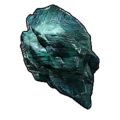Difference between revisions of "Amethystos"
Tag: Manual revert |
|||
| (One intermediate revision by one other user not shown) | |||
| Line 43: | Line 43: | ||
|Lukium | |Lukium | ||
}} | }} | ||
}}<section begin=summary/>'''Amethystos''' ({{IPAc-en|a:|.|m| | }}<section begin=summary/>'''Amethystos''' ({{IPAc-en|a:|.|m|ɛ|.|ˈ|θ|uː|s|.|t|oʊ|s|}}) is an unusually dark moon approximately 70,000 kilometers away from [[Eos]]. During the day, its sky glows with fuchsia and a light purple, to which it owes its namesake. Since its atmosphere is held closely to the surface, ground-level fog quickly obscures the relatively flat terrain, with notable exception in mountainous regions which often extend above the atmospheric layer.<section end=summary/> | ||
==Nomenclature== | ==Nomenclature== | ||
Amethyste or Amethystos is supposedly a nymph in [[wikipedia:Greek mythology|Greek mythology]] who is turned into a precious stone by the goddess [[wikipedia:Diana (mythology)|Diana]] in order to avoid a worse fate at the hands of the god [[wikipedia:Dionysus|Dionysus]], thus explaining the origin of the semi-precious stone [[wikipedia:Amethyst|amethyst]]. Although this tale has circulated a lot in various sites and books, no ancient source attests to it, and its origin is much later than either ancient Greece or Rome. | Amethyste or Amethystos is supposedly a nymph in [[wikipedia:Greek mythology|Greek mythology]] who is turned into a precious stone by the goddess [[wikipedia:Diana (mythology)|Diana]] in order to avoid a worse fate at the hands of the god [[wikipedia:Dionysus|Dionysus]], thus explaining the origin of the semi-precious stone [[wikipedia:Amethyst|amethyst]]. Although this tale has circulated a lot in various sites and books, no ancient source attests to it, and its origin is much later than either ancient Greece or Rome. | ||
[[Category:Moons]] | |||
[[Category:Atmosphere - Surtrite/Karnite]] | [[Category:Atmosphere - Surtrite/Karnite]] | ||
Latest revision as of 00:51, 4 August 2024
(Ancient Greek) - IPA(key)
Amethystos (/ɑː.mɛ.ˈθuːs.toʊs/) is an unusually dark moon approximately 70,000 kilometers away from Eos. During the day, its sky glows with fuchsia and a light purple, to which it owes its namesake. Since its atmosphere is held closely to the surface, ground-level fog quickly obscures the relatively flat terrain, with notable exception in mountainous regions which often extend above the atmospheric layer.
Nomenclature
Amethyste or Amethystos is supposedly a nymph in Greek mythology who is turned into a precious stone by the goddess Diana in order to avoid a worse fate at the hands of the god Dionysus, thus explaining the origin of the semi-precious stone amethyst. Although this tale has circulated a lot in various sites and books, no ancient source attests to it, and its origin is much later than either ancient Greece or Rome.











